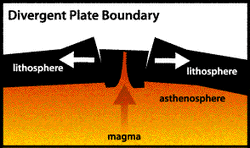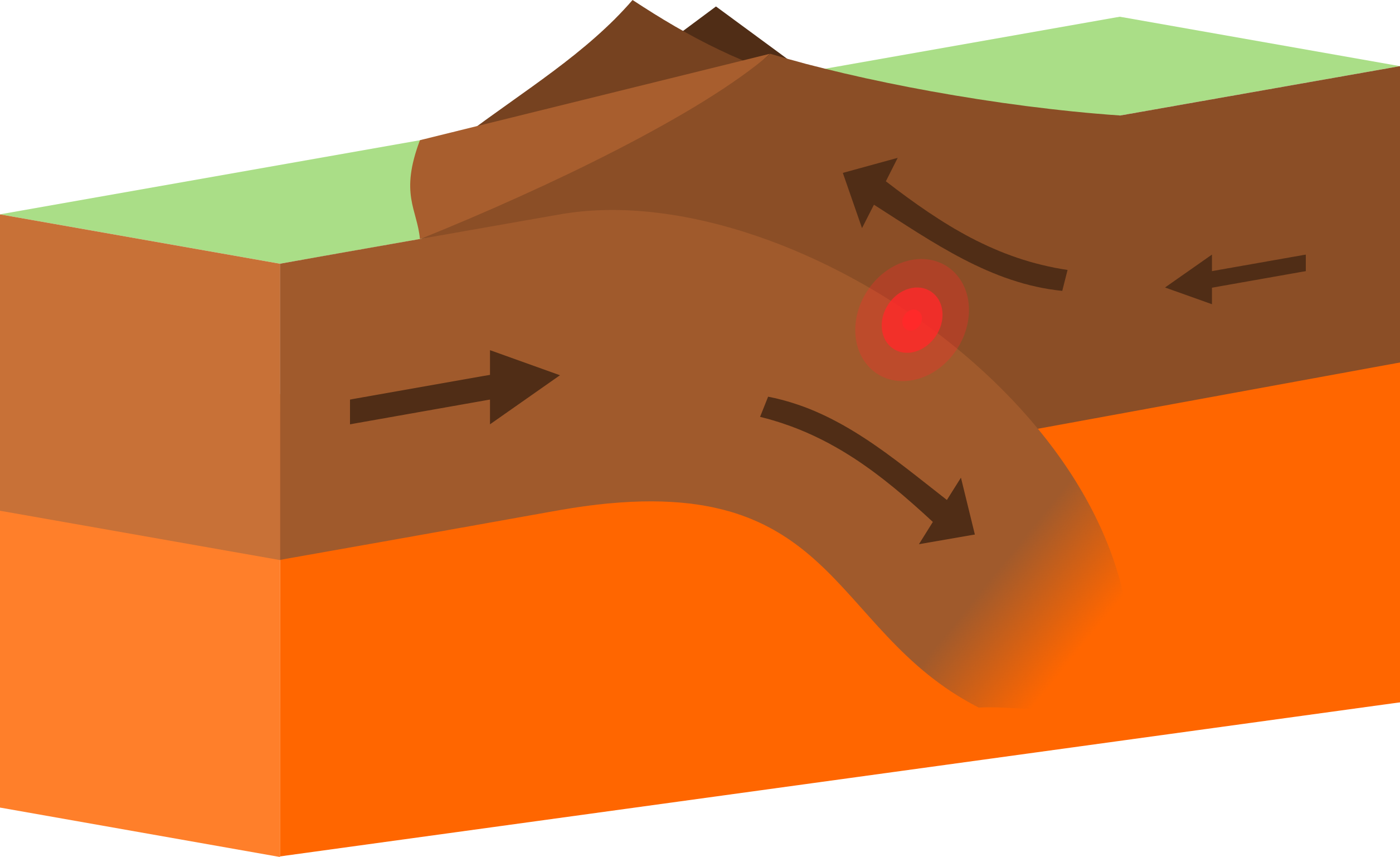


Shallow earthquakes and minor basaltic lava flows characterize divergent boundaries at mid-ocean ridges. The most common divergent boundaries are the mid-ocean ridges that launched the plate tectonics revolution, and the Mid-Atlantic Ridge is a classic example (see Figure 3). Continental crust is thick and buoyant oceanic crust is thin, dense, and forms at mid-ocean ridges. The results of these interactions also depend on the type of crust involved, and there are two types of crust: oceanic and continental. Each of these interactions produces a different and characteristic pattern of earthquakes, volcanic activity, and topography. There are three major ways that plates interact along boundaries: (1) They can move away from each other (diverge), (2) they can move toward each other (converge), or (3) they can move past each other, parallel to the boundary (transform). In general, plate boundaries are the scene of much geologic action - earthquakes, volcanoes, and dramatic topography such as mountain ranges like the Himalayas are all concentrated where two or more plates meet along a boundary. In addition, they helped scientists recognize that there are other types of plate boundaries. These observations about the distribution of earthquakes and volcanoes helped geologists define the processes that occur at spreading ridges and subduction zones. This type of volcano is represented by blue triangles in Figure 2. In contrast, the volcanic eruptions that occur along spreading ridges are much gentler, in part because most of these eruptions occur under 2 to 3 kilometers of water, but also because the magma is far less viscous. These devastating, explosive eruptions reflect the composition of the magma - it is extremely viscous, or thick and resistant to flow, and thus results in tall, steep-sided volcanoes. This type of volcano is represented by green triangles in Figure 2. Helens eruption, take place near subduction zones. Most of the volcanic eruptions that make the news, such as the 1980 Mount St. image ©Īlso similar to earthquakes, different kinds of volcanoes occur along different types of plate boundaries. Data are from the Smithsonian Institution, Global Volcanism Program. Colored triangles indicate different volcano types: Red triangles are primarily calderas green triangles are stratovolcanoes blue triangles are shield volcanoes and fissure vents. Map showing volcanoes that have been active in the last 10,000 years. Similar to earthquakes, volcanoes are located preferentially on or near plate boundaries (see Figure 2). These data helped geologists draw more detailed cross-sections showing that plates are thin at spreading ridges, and that subduction extends long distances, taking plates deep beneath the continents. On the other hand, only shallow earthquakes (depths of 0 to 33 km, shown in red in Figure 1) are recorded at the spreading ridges. Where Hess had postulated that the rocks of the ocean floor were diving down into subduction zones, earthquakes occur at shallow depths of 0 to 33 km below the surface near the trenches and at depths of almost 700 km below the surface further inland (illustrated in Figure 1 by different colored circles). Not all earthquakes occur at the same depth, however. In fact, earthquakes are concentrated along the plate boundaries drawn by Harry Hess along mid-ocean ridges and subduction zones. Data are from the Advanced National Seismic System. Colors indicate depth of hypocenter, or origin of the earthquake: Red is 0-33 km, yellow is 33-100 km, green is 100-400 km, and blue is >400 km depth. Map showing earthquakes from 2003-2011 with magnitude greater than 3. For example, geologists had long recognized that earthquakes are not randomly distributed on the Earth (see Figure 1). The concepts of continental drift and seafloor spreading had revolutionized geology (see our module The Origins of Plate Tectonic Theory), and scientists excitedly began to revise their interpretations of existing data into a comprehensive theory of plate tectonics. Understanding Scientific Journals and Articlesīy 1962, the idea that pieces of the Earth's surface moved around no longer seemed radical.Using Graphs and Visual Data in Science.Scientists and the Scientific Community.Scientific Notation and Order of Magnitude.The Case of the Ivory-billed Woodpecker.Santiago Ramón y Cajal and Camillo Golgi.Factors that Control Earth's Temperature.

Plates, Plate Boundaries, and Driving Forces.Solutions, Solubility, and Colligative Properties.Y-Chromsome and Mitochondrial DNA Haplotypes.Absorption, Distribution, and Storage of Chemicals.


 0 kommentar(er)
0 kommentar(er)
